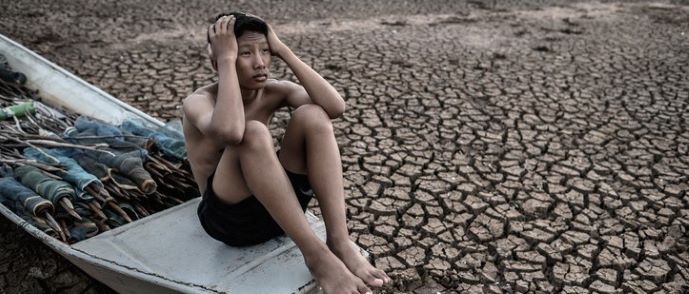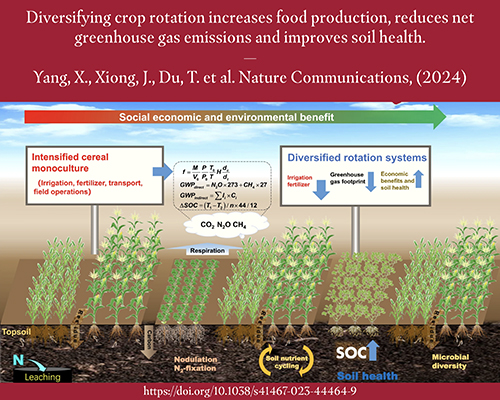Reassessing Climate Change’s Economic Impact in the Context of Sustainable Development Goals
Introduction
A recent analysis by Kotz, Levermann, and Wenz (KLW) posited a severe threat to global economic stability, projecting that climate change could reduce global Gross Domestic Product (GDP) by 62% by 2100 under a high-emissions scenario. This finding has profound implications for the achievement of several Sustainable Development Goals (SDGs), particularly SDG 8 (Decent Work and Economic Growth) and SDG 13 (Climate Action). However, a subsequent review of the KLW study has identified significant methodological issues that challenge the severity of these projections. This report details a re-evaluation of the KLW findings, focusing on data anomalies and statistical underestimations that fundamentally alter the projected economic commitment of climate change.
Methodological Critique and Implications for SDG 8 and SDG 13
Data Anomalies and the Integrity of Economic Projections
The integrity of data is paramount for creating policies that effectively advance the 2030 Agenda for Sustainable Development. The KLW study’s conclusions are heavily influenced by anomalous data from a single country, Uzbekistan, within the subnational GDP dataset used. This reliance on flawed data compromises the accuracy of the climate impact assessment, which is a critical component of planning for SDG 13 (Climate Action).
- The underlying GDP dataset for Uzbekistan contains substantial anomalies that bias the predicted impacts of climate change.
- These data points create a distorted relationship between climate variables (temperature, precipitation) and economic growth.
- When this single country’s data is removed, the projected global economic damage is significantly reduced.
This highlights a critical challenge for SDG 17 (Partnerships for the Goals), which relies on the availability and sharing of high-quality, reliable data to monitor progress and inform global strategies.
Underestimation of Statistical Uncertainty
The KLW analysis also underestimates the statistical uncertainty in its future projections. By not fully accounting for spatial correlations in the data, the study presents its findings with a higher degree of certainty than is statistically justifiable. For policymakers working towards SDG 8 and SDG 13, understanding the full range of potential outcomes is essential for robust risk management and resource allocation. An artificially narrow confidence interval can lead to misinformed policy decisions, potentially misdirecting efforts to build resilient infrastructure and promote sustainable economic models as outlined in SDG 9 (Industry, Innovation, and Infrastructure).
Revised Projections and Alignment with Global Goals
Corrected Economic Impact Estimates
Upon correcting for the identified issues, the projected economic impact of climate change is substantially moderated. The revised analysis provides a different perspective on the economic trade-offs central to achieving global sustainability targets.
- Removal of Anomalous Data: Excluding the Uzbekistan data from the model brings the central estimate of economic impact in line with previous, less severe estimates from the scientific literature.
- Correction for Uncertainty: When statistical uncertainty is properly calculated to account for spatial correlations, the results are no longer statistically distinguishable from the costs of mitigation at any point in the 21st century.
- Alignment with Previous Research: The corrected projections suggest that the economic damages from climate change, while significant, are not on the order of magnitude originally reported by KLW. This recalibrates the economic case for immediate and decisive climate action under SDG 13.
Implications for Sustainable Development Policy
The revised findings underscore that the costs of climate change mitigation are economically rational when compared to the potential damages. This strengthens the argument that investments in climate action are not a burden on economic growth but a prerequisite for the sustainable, long-term prosperity envisioned in SDG 8. Accurately quantifying climate risk is essential to protect vulnerable populations and prevent setbacks in achieving SDG 1 (No Poverty) and SDG 10 (Reduced Inequalities), as these groups are disproportionately affected by both climate impacts and economic instability.
Conclusion: The Critical Role of Data Accuracy for the 2030 Agenda
This re-evaluation demonstrates that data anomalies and statistical methodology can dramatically alter conclusions about the economic consequences of climate change. The initial, alarming projections from the KLW study were largely an artifact of correctable flaws. For the global community to successfully navigate the challenges of the 21st century, it is imperative that the scientific analysis underpinning policy is rigorous, transparent, and robust. The achievement of the Sustainable Development Goals, from ensuring sustainable economic growth (SDG 8) to taking urgent climate action (SDG 13), depends on a foundation of credible and accurately interpreted data.
Analysis of Sustainable Development Goals (SDGs) in the Article
1. Which SDGs are addressed or connected to the issues highlighted in the article?
-
SDG 8: Decent Work and Economic Growth
The article is fundamentally about the impact of climate change on economic performance. It directly discusses how “subnational gross domestic product (GDP) growth responds to year-to-year changes in temperature and precipitation” and evaluates projections that “global GDP would be lowered by roughly 62%”. This focus on GDP and economic production establishes a clear link to SDG 8, which aims to promote sustained, inclusive, and sustainable economic growth.
-
SDG 13: Climate Action
The core subject is the “economic commitment of climate change.” The analysis revolves around the consequences of a “‘high emissions’ scenario” and the impacts of “changes in temperature and precipitation.” By quantifying the economic damages of climate change and discussing “mitigation costs,” the article directly contributes to the understanding needed to take urgent action to combat climate change and its impacts, which is the central goal of SDG 13.
-
SDG 17: Partnerships for the Goals
The article critiques a previous study based on “data anomalies,” “underestimate[d] statistical uncertainty,” and “data-quality concerns in… subnational GDP data.” This highlights the critical importance of reliable and high-quality data for policymaking and scientific analysis. SDG 17, particularly its targets on data, monitoring, and accountability, emphasizes the need to “increase significantly the availability of high-quality, timely and reliable data disaggregated by… geographic location.” The scientific dialogue presented in the article is itself a form of partnership aimed at strengthening the knowledge base for sustainable development.
2. What specific targets under those SDGs can be identified based on the article’s content?
-
SDG 8: Decent Work and Economic Growth
- Target 8.1: “Sustain per capita economic growth in accordance with national circumstances…” The article directly addresses this target by analyzing how climate change threatens the sustainability of GDP growth. The projection of a massive reduction in global GDP under a high-emissions scenario shows a direct conflict with the goal of sustaining economic growth.
-
SDG 13: Climate Action
- Target 13.1: “Strengthen resilience and adaptive capacity to climate-related hazards and natural disasters in all countries.” The article’s analysis of how economic growth responds to “changes in temperature and precipitation” is a key step in understanding vulnerabilities to climate-related hazards, which is essential for building economic resilience.
- Target 13.2: “Integrate climate change measures into national policies, strategies and planning.” By providing refined estimates of the economic impacts of climate change, the research offers crucial information for policymakers to justify and design climate change measures and integrate them into economic planning.
-
SDG 17: Partnerships for the Goals
- Target 17.18: “…increase significantly the availability of high-quality, timely and reliable data disaggregated by income, gender, age, race, ethnicity, migratory status, disability, geographic location and other characteristics relevant in national contexts.” The article’s entire argument hinges on this target. It identifies “data anomalies arising from one country… Uzbekistan” and “data-quality concerns in KLW’s subnational GDP data,” demonstrating the necessity of accurate and reliable subnational data for global analysis.
- Target 17.19: “…build on existing initiatives to develop measurements of progress on sustainable development that complement gross domestic product…” While the article uses GDP as its primary metric, its critique of how economic impacts are calculated contributes to the broader effort to refine measurements of progress in the context of environmental challenges.
3. Are there any indicators mentioned or implied in the article that can be used to measure progress towards the identified targets?
-
For SDG 8:
- Indicator 8.1.1: Annual growth rate of real GDP per capita. This is the central indicator used throughout the article. The analysis focuses on “subnational gross domestic product (GDP) growth” and the projected lowering of “global GDP.” The percentage change in GDP is the key metric of climate impact discussed.
-
For SDG 13:
- Economic losses from climate change: The article implies the use of economic loss as a key indicator of climate impact. The finding that “global GDP would be lowered by roughly 62%” serves as a direct measure of the economic consequences of failing to take climate action.
- Changes in climatic conditions: The study uses “year-to-year changes in temperature and precipitation” as the independent variables causing economic effects. These are direct indicators of climate change being measured.
-
For SDG 17:
- Availability and quality of disaggregated data: The article’s focus on the “DOSE subnational GDP dataset” and the “anomalous Uzbekistan data” implies that the quality, consistency, and reliability of such datasets are crucial indicators. The critique itself serves as a quality assessment of the statistical inputs used for monitoring global trends.
- Statistical uncertainty margins: The argument that the original study “underestimate[s] statistical uncertainty” suggests that the robustness and confidence level of statistical projections are important implied indicators for data quality and capacity.
4. Table of SDGs, Targets, and Indicators
| SDGs | Targets | Indicators |
|---|---|---|
| SDG 8: Decent Work and Economic Growth | 8.1: Sustain per capita economic growth. | 8.1.1 (Implied): Annual growth rate of real GDP per capita (The article analyzes “subnational gross domestic product (GDP) growth” and projects impacts on “global GDP”). |
| SDG 13: Climate Action | 13.1: Strengthen resilience and adaptive capacity to climate-related hazards. 13.2: Integrate climate change measures into national policies. |
Implied: Economic losses as a percentage of GDP due to climate change (e.g., “global GDP would be lowered by roughly 62%”). Implied: Measurement of climatic variables (“year-to-year changes in temperature and precipitation”). |
| SDG 17: Partnerships for the Goals | 17.18: Enhance capacity-building to increase the availability of high-quality, timely and reliable data disaggregated by geographic location. | Implied: Quality and reliability of subnational economic data (The article critiques “data anomalies” and “data-quality concerns in… subnational GDP data”). Implied: Measurement of statistical uncertainty in projections. |
Source: nature.com







